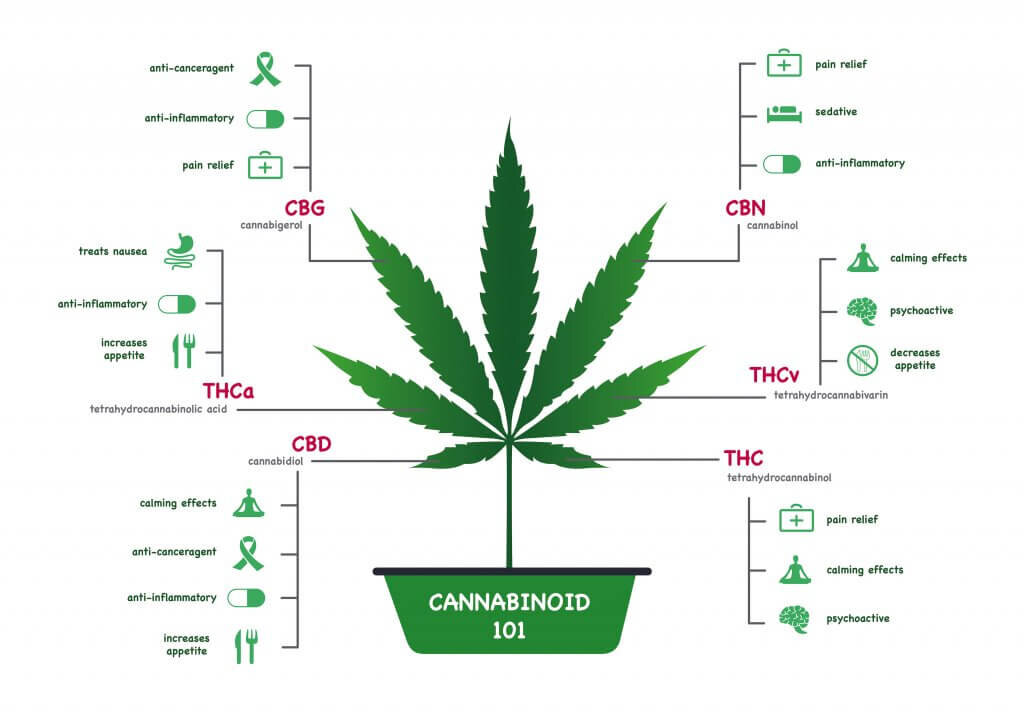A Half Dozen Cannabinoids You've Probably Never Heard Of
Over the past few decades, since scientific research into cannabis began in earnest, researchers have isolated and identified more than 400 chemical compounds. About a quarter of these (more than 100!) are classified as cannabinoids and are unique to cannabis plants. Although Cannabis is notorious for its psychoactive effects, the majority of cannabinoids aren’t psychoactive. Cannabinoids are secondary metabolites (as opposed to primary metabolites like proteins and lipids) that are responsible for many of the therapeutic effects of cannabis. THC and CBD have become part of our lexicon, but there are several other that seem to have many benefits of their own. And more are still being discovered—new cannabinoids CBDP and THCP were discovered by Italian researchers just this past December! Since I don’t have time to go through all 100+, we’ll just look at the Big 6:
As I noted earlier, THC and CBD are more or less household terms at this point, so we’ll more or less skip over them. But if you would like further information check out our earlier posts on CBD and THC!
CBC - Cannabichromene, or CBC, is the most common cannabinoid after THC and CBD. CBC doesn’t bind to the CB1 receptors found in our central nervous system (CNS), and therefore is not psychoactive. CBC binds not only to CB2 receptors, but also with non-cannabinoid receptors—specifically Vanilloid (TRPV1) and transient receptor potential ankyrin 1 (TRPA1) receptors, both of which are linked to pain perception. By binding to these receptors CBC both works as an analgesic and increases the production of endocannabinoids. In addition to reducing pain studies suggest that CBC is an effective antidepressant, anti-inflammatory, anti-proliferative (inhibits tumor growth in cancer patients), and promotes bone growth (meaning it may have applications for patients with osteoporosis and other degenerative bone diseases).
CBN - Cannabinol, or CBN, is often referred to as a non-natural cannabinoid because it is not directly produced by cannabis plants. CBN is a breakdown product of THC oxidation, meaning that the longer you have flower lying around the higher the CBN concentration will be. (And the lower its THC concentration will be.) Especially if it’s not stored in an airtight container or it’s exposed to light. CBN is mildly psychoactive and has heavy sedative properties. Research also shows CBN to have anticonvulsant, anti-inflammatory, and antibiotic properties.
CBG - Cannabigerol, or CBG, is the ‘foundation’ for other cannabinoids. Depending on the enzymatic process CBG undergoes it turns into CBCA, CBDA, or THCA—the acid forms that breakdown into CBC, CBD, and THC. But CBG also has several therapeutic benefits of its own. CBG binds to cannabinoid receptors in the eye and reduces intraoccular pressure, which is a big part of why cannabis is effective at treating glaucoma. Studies done on mice also show CBG to be an effective anti-proliferative (particularly in colorectal cancer) and antibiotic (especially with MRSA and skin infections), and protects against nerve cell degeneration associated with Huntington’s disease. Research has also shown CBG to reduce inflammation in IBS patients, to inhibit bladder contractions, and to have analgesic and antidepressant applications. Scientists are working on isolating CBG, and companies like Subcool Seeds have been working to breed strains with higher CBG concentrations.
THC-V - Tetrahydrocannabivarin, or THC-V is very molecularly similar to THC (differentiated only by a 3 carbon vs. a 5 carbon group) and is only found in some strains—particularly African landrace strains. THC-V might have some psychoactive properties and is an effective appetite suppressant (so if your not feeling the munchies it might be worth trying to find strains with relatively high THC-V strains!) that might help treat diabetes by regulating blood sugar and decreasing insulin resistance. THC-V also shows some promise in decreasing anxiety attacks without suppressing emotions and might improve motor control and reduce tremors and brain lesions in patients with Alzheimers.
And while cannabis is the only plant that synthesizes cannabinoids, it’s not the only place cannabinoids are found. Let’s not forget that all mammals, humans included, produce their own endogenous cannabinoids to help maintain homeostasis via the body’s endocannabinoid system! (For more information on The Endocannabinoid System check out our earlier post!)
Anandamide - Anandamide is known as the ‘bliss molecule’ and is produced in the part of the brain responsible for memory, movement control, and advanced thought processes. Its name is derived from the sanskrit word ananda, meaning ‘supreme joy’ and its structure is very similar to that of THC. Anandamide plays a role in appetite management, pain management, and fertility. It binds to both CB1 and CB2 receptors and is known as a ‘fragile compound’ because, once absorbed, it quickly breaks down into its components.
2AG - 2-Arachidonoylglycerol, or 2-AG, is the primary binding molecule of CB2 receptors. In addition to effecting appetite regulation and pain management it plays a crucial role in immune system functions. Individuals can promote the production of 2-AG by adjusting their diet to include foods high in linoleic acid (such as eggs, poultry, grains, and hemp seeds) and Omega 3 and Omega 6 acids. 2-AG effects can also be promoted by including probiotics and foods like leeks, artichokes, onions, garlic, and high fiber greens in your routine to increase the function of CB2 receptors in the gut.



